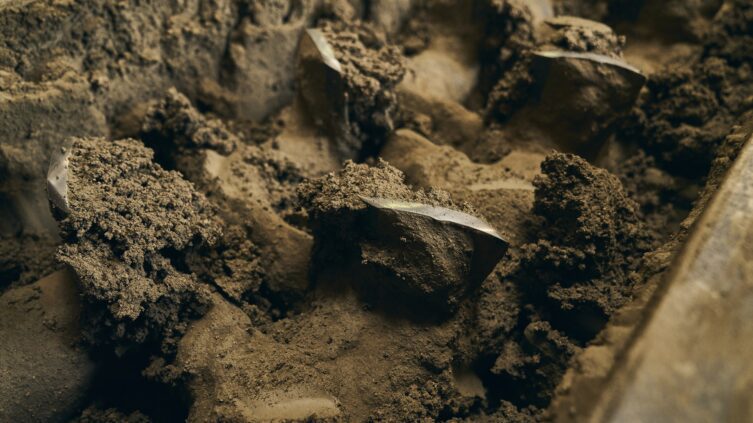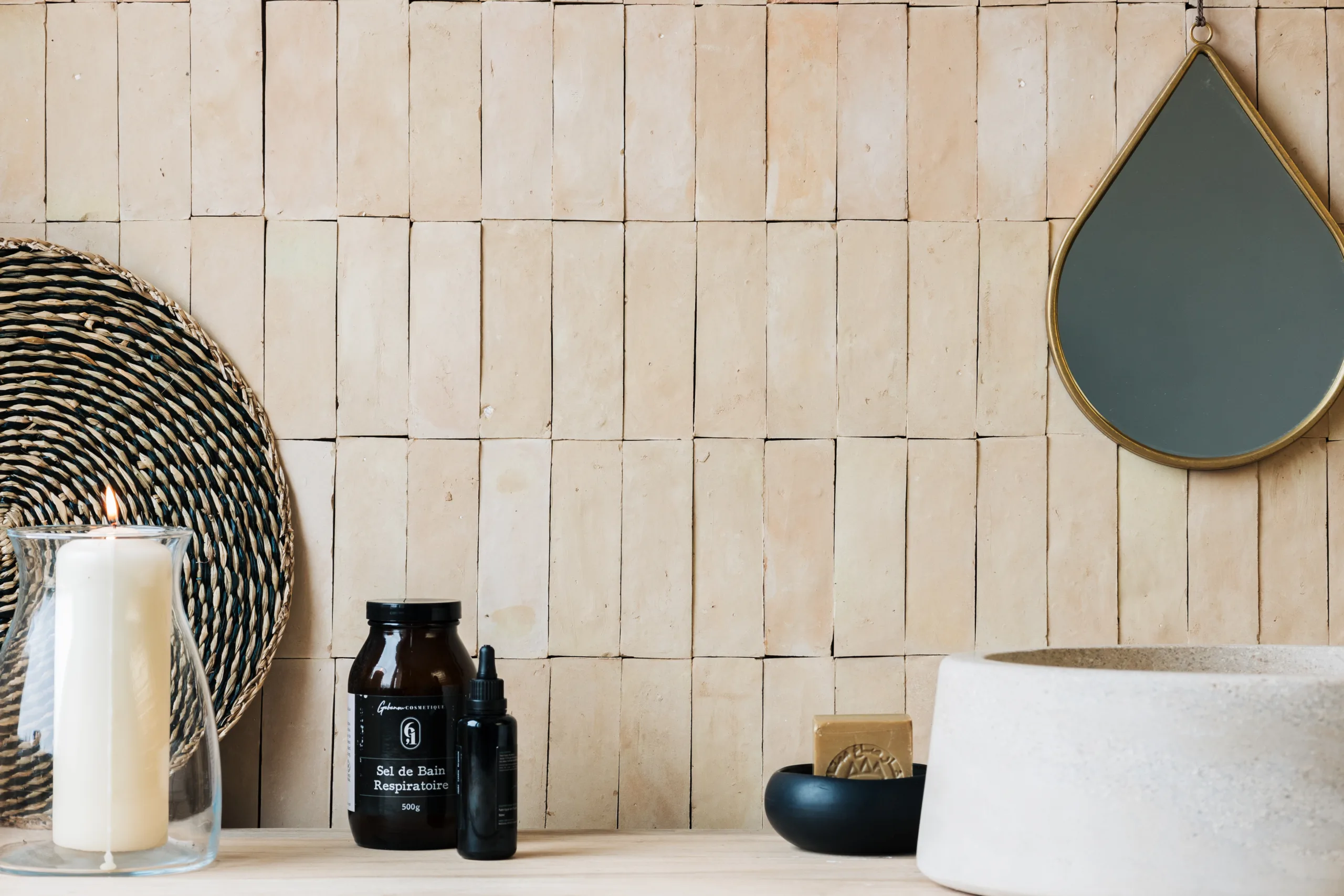Zellij, also known as zellige, is a form of terracotta tilework covered with enamel in the form of chips set into plaster. This intricate form of mosaic tilework is a cornerstone of Moroccan architecture, renowned for its beauty and craftsmanship. Originating in the Islamic art tradition, Zellij has been a prominent feature in Moroccan buildings for centuries, adorning mosques, palaces, and public spaces with its vibrant colors and geometric patterns. This article explores the cultural heritage of Zellij, its historical significance, and its enduring impact on both traditional and contemporary architecture.
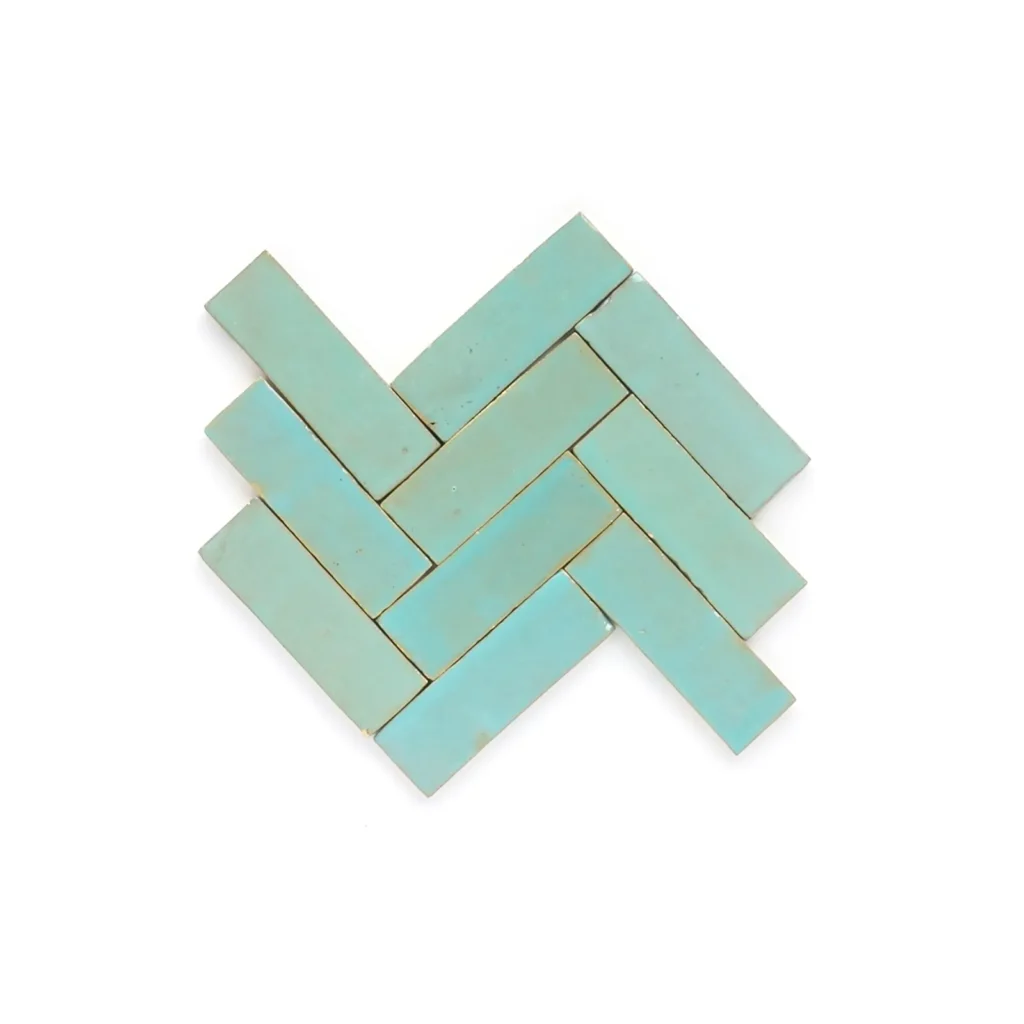
Introduction to Zellij
1.1 Overview of Zellij in Moroccan Architecture
Zellij, also spelled zellige, is a form of Islamic art and a prominent feature in Moroccan architecture. These intricate mosaic tiles are made from individually hand-chiseled ceramic pieces set into a plaster base.
The origins of Zellij date back to at least the 10th century, with some evidence suggesting even earlier beginnings in the Maghreb region. The technique flourished under the Marinid dynasty in the 14th century, especially in cities like Fez and Meknes.
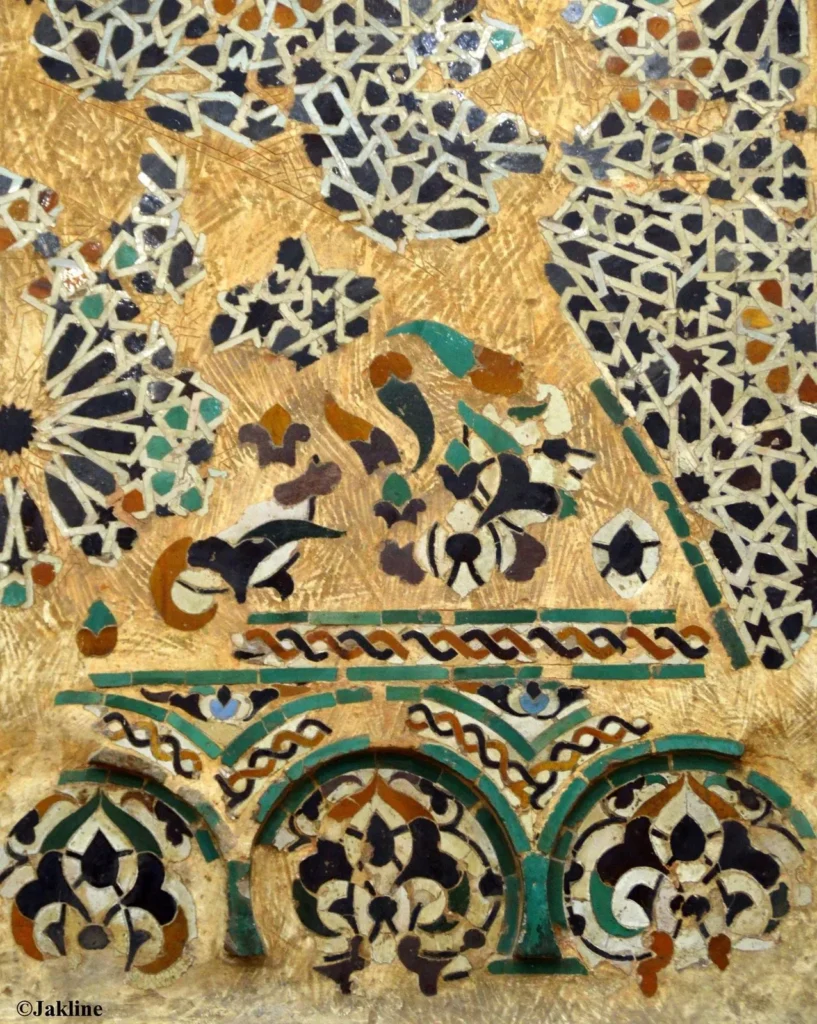
Each tile, called a tessera, is carefully crafted to fit into a larger geometric pattern, creating elaborate designs that are both visually stunning and structurally significant for Moroccan Arquitecture. The production of Zellij tiles are labor-intensive processes, requiring skilled craftsmanship passed down through generations.
1.2 Prominence and Role in Moroccan Architecture
Zellij holds a prominent place in Moroccan architecture, often used to decorate key elements of buildings such as walls, floors, fountains, pools, and columns. The use of Zellij is particularly significant in religious and public buildings, including mosques, madrasas (Islamic schools), palaces, and hammams (public baths).
For instance, the Al-Attarine Madrasa in Fez, built in 1325, showcases some of the finest examples of Zellij work. The intricate tilework not only serves a decorative purpose but also reflects the sophistication and cultural depth of Moroccan society. The vibrant colors and complex patterns of Zellij make it an enduring symbol of Moroccan art, illustrating the country’s rich history and cultural diversity. The continued use of Zellij in contemporary architecture underscores its lasting significance and adaptability.
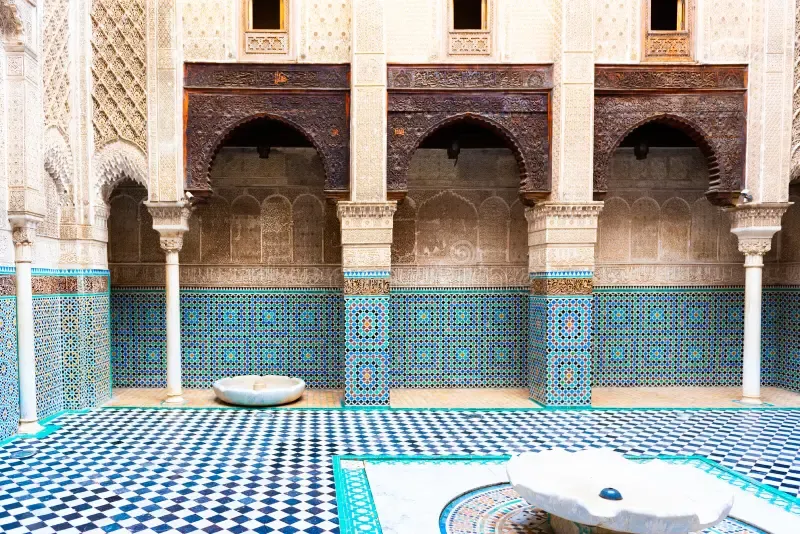
1.3 Influence of Islamic Art on Zellij
The design and patterns of Zellij are deeply influenced by Islamic art, which emphasizes non-figurative decoration such as geometric shapes, arabesques, and calligraphy. Islamic art, which began to flourish in the 7th century, avoids the depiction of living beings, focusing instead on abstract and intricate designs that symbolize the infinite nature of creation and the unity of Allah.
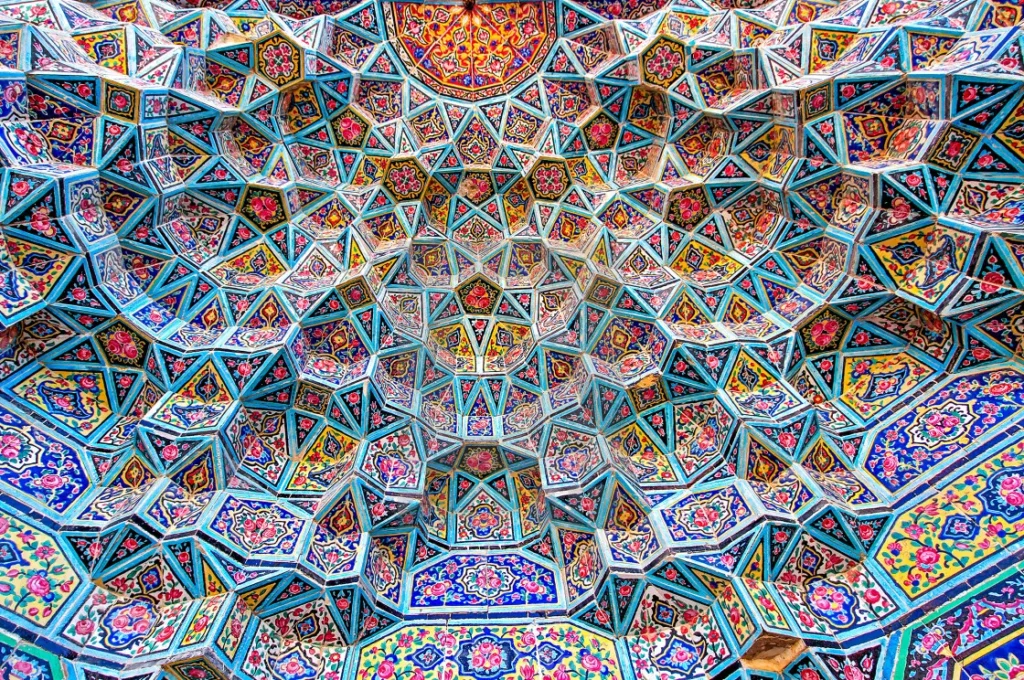
Zellij tiles often feature complex geometric patterns, including star shapes, polygons, and interlaced forms, which are repeated to create a sense of harmony and order. The use of mathematical principles in the design of Zellij is a testament to the advanced understanding of geometry and algebra in the Islamic Golden Age, particularly during the Abbasid Caliphate from the 8th to the 13th centuries.
Vibrant colors such as cobalt blue, emerald green, saffron yellow, and ruby red are commonly used, each carrying symbolic meanings. For example, blue represents protection and spirituality, green symbolizes paradise in Islamic culture, and red signifies power and bravery. The meticulous craftsmanship and artistic expression found in Zellij tiles reflect the broader traditions of Islamic art and architecture, making them an integral part of Morocco’s cultural and historical heritage.
Historical Significance of Zellij
2.1 Historical Roots of Zellij
The historical roots of Zellij can be traced back to the 10th century, with early examples found in the Great Mosque of Kairouan in Tunisia, built in 836 AD. The technique likely spread to Morocco through Andalusian artisans who migrated following the Reconquista. This early period saw the establishment of Zellij as a significant decorative art form, influenced by the broader Islamic artistic traditions of the Maghreb region.
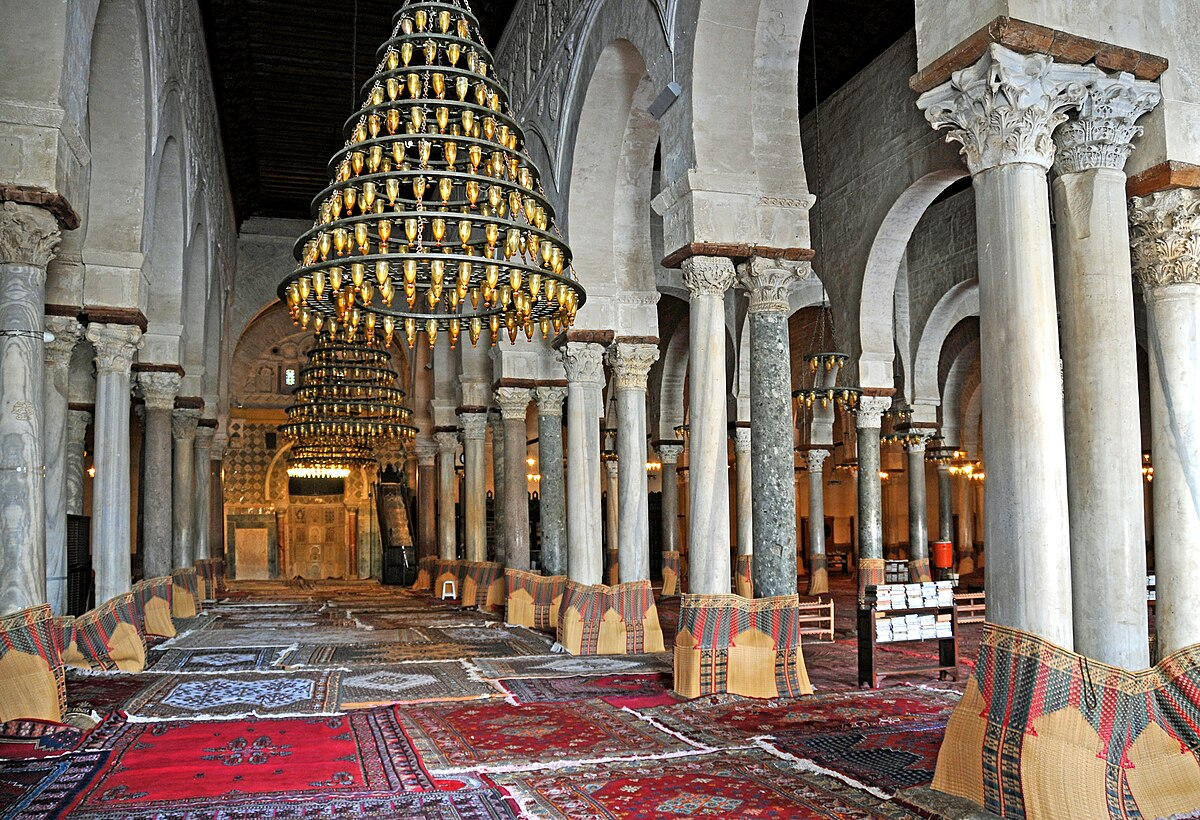
2.2 Evolution Through the Medieval Period
Zellij reached its peak during the Marinid dynasty in the 14th century, a period marked by cultural and architectural advancements in Morocco. The Marinid rulers, who reigned from 1244 to 1465, were great patrons of the arts and commissioned numerous buildings adorned with Zellij. Notable examples from this period include the Bou Inania Madrasa and the Al-Attarine Madrasa in Fez, both of which feature intricate Zellij tilework that exemplifies the height of Moroccan craftsmanship. The evolution of Zellij during this time reflects the refinement of techniques and the increasing complexity of designs, establishing it as a key element of Moroccan architectural identity.

2.3 Contribution of Moroccan Artisans
Moroccan artisans, known as maâlems, have played a crucial role in the development and preservation of Zellij. These skilled craftsmen undergo extensive training, often through apprenticeships, to master the techniques required to create Zellij tiles. The process involves shaping, glazing, and precisely cutting the tiles, followed by their assembly into complex geometric patterns. The maâlems’ expertise ensures that each piece fits perfectly into the larger design, maintaining the integrity and beauty of Zellij. The contributions of these artisans are evident in the enduring presence of Zellij in Moroccan architecture and its continued relevance in contemporary design.
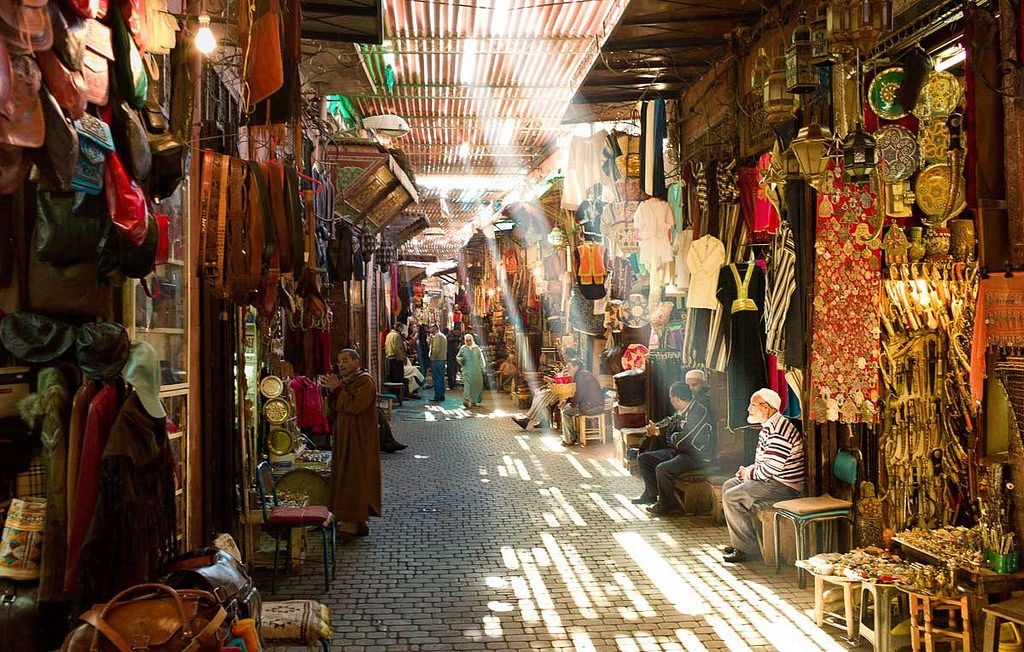
Cultural Importance of Zellij
3.1 Cultural Significance in Moroccan Society
Zellij is a significant cultural symbol in Moroccan society, representing centuries of artistic heritage and craftsmanship. The intricate tilework is more than just decorative; it is a testament to the skill and creativity of Moroccan artisans. Zellij tiles are commonly used in public spaces, homes, and religious buildings, where they serve both aesthetic and functional purposes. The patterns and colors of Zellij reflect the rich cultural history of Morocco, blending influences from Berber, Arab, and Andalusian art forms. The craftsmanship involved in creating Zellij is often passed down through generations, with artisans dedicating their lives to perfecting this traditional art. This dedication helps preserve cultural identity and continuity in Moroccan society.
3.2 Religious Importance in Mosques and Palaces
Zellij holds particular importance in the decoration of mosques and palaces, where it is used to convey religious and royal grandeur. In Islamic culture, the use of geometric patterns and calligraphy in art serves to avoid the depiction of living beings, which is prohibited. Instead, these patterns are used to symbolize the infinite nature of Allah. The Hassan II Mosque in Casablanca, completed in 1993, features extensive Zellij work, with over 10,000 square meters of intricate tile mosaics. The Alhambra in Granada, Spain, although not in Morocco, also showcases the pinnacle of Zellij artistry, reflecting the historical influence of Moroccan artisans. The use of Zellij in these religious and royal contexts underscores its role in expressing spiritual and temporal power.
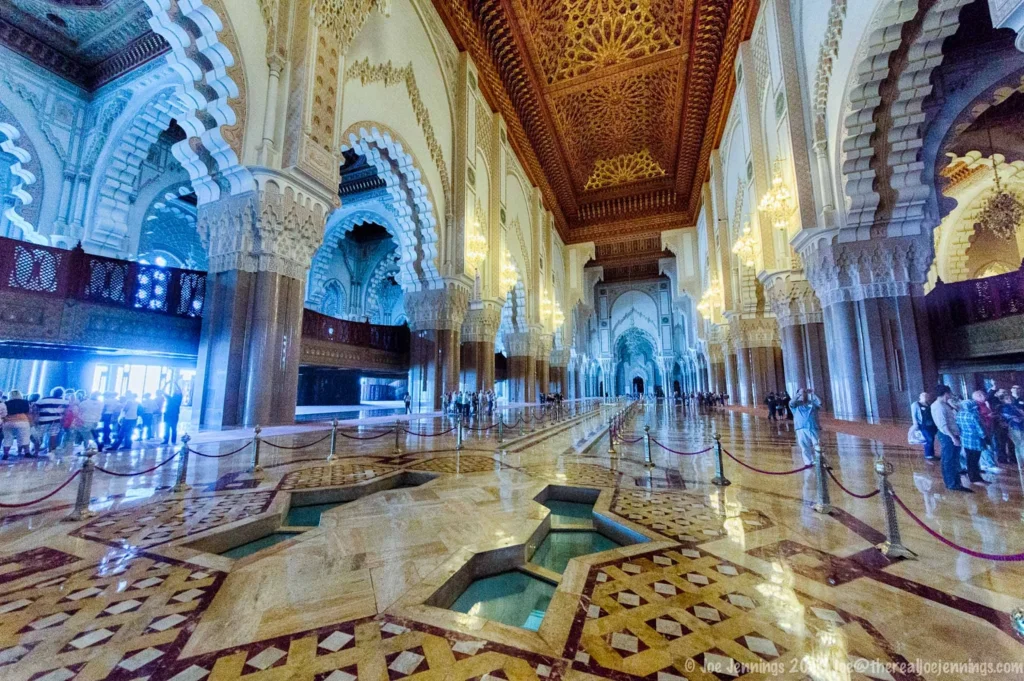
3.3 Role in Preserving Traditional Art
Zellij plays a crucial role in preserving traditional Moroccan art forms. The techniques used to create these tiles have remained largely unchanged for centuries, ensuring the transmission of this craft from one generation to the next. Organizations such as the Moroccan Ministry of Culture and various cultural heritage foundations actively work to preserve and promote Zellij craftsmanship. Efforts include the establishment of training programs for young artisans and the restoration of historical sites featuring Zellij. For instance, the restoration of the Bou Inania Madrasa in Fez, a UNESCO World Heritage site, involved meticulous work by skilled artisans to restore its original Zellij decor. These efforts are essential in maintaining the cultural heritage of Morocco and ensuring that the art of Zellij continues to thrive in modern times.
Artistic Techniques
4.1 Handcrafting Techniques
The creation of Zellij tiles involves meticulous handcrafting techniques that have been refined over centuries. The process begins with the preparation of natural clay, which is shaped into square tiles and dried in the sun. Once dried, these tiles are glazed and fired in kilns at temperatures ranging from 900 to 1,000 degrees Celsius. After firing, the tiles are hand-cut into precise geometric shapes using a small adze-like hammer known as a menqach. This step is critical, as each piece must fit perfectly into the larger mosaic. The handcrafted nature of Zellij ensures that no two pieces are exactly alike, adding to the unique beauty of each installation.
4.2 Geometric Designs and Patterns
Geometric designs and patterns are central to the aesthetic of Zellij, reflecting the mathematical precision and artistic creativity of Islamic art. These patterns often include complex arrangements of stars, polygons, and interlaced forms, which are repeated to create a sense of harmony and order. The design process requires an advanced understanding of geometry and symmetry, skills that are honed through years of practice. Research has shown that many of these patterns are based on intricate mathematical principles, including tessellations and transformations. The use of geometry in Zellij not only serves an aesthetic purpose but also carries symbolic meanings, representing the infinite nature of Allah and the interconnectedness of creation.
4.3 Traditional Methods in Modern Context
While the traditional methods of creating Zellij have remained largely unchanged, modern applications have introduced new contexts for this ancient art form. Today, Zellij tiles are not only used in traditional settings such as mosques and palaces but also in contemporary interior design and architecture. Modern architects and designers often incorporate Zellij into their projects to add a touch of Moroccan elegance and authenticity.
This fusion of old and new has led to innovative uses of Zellij in a variety of settings, including luxury hotels, restaurants, and private residences. The integration of traditional methods into modern design demonstrates the versatility and enduring appeal of Zellij. For instance, the use of Zellij in modern projects often involves advanced computer modeling to create custom patterns, ensuring precision and consistency while maintaining the handcrafted quality of the tiles.
Iconic Examples of Zellij Art
5.1 Alhambra: A Testament to Zellij Craftsmanship
The Alhambra, a palace and fortress complex located in Granada, Spain, is one of the most iconic examples of Zellij craftsmanship. Built during the Nasrid dynasty in the 13th and 14th centuries, the Alhambra showcases the intricate tilework that defines Zellij art. The use of geometric patterns, vibrant colors, and detailed designs in the Alhambra’s courtyards, halls, and walls exemplifies the zenith of Islamic art and architecture.
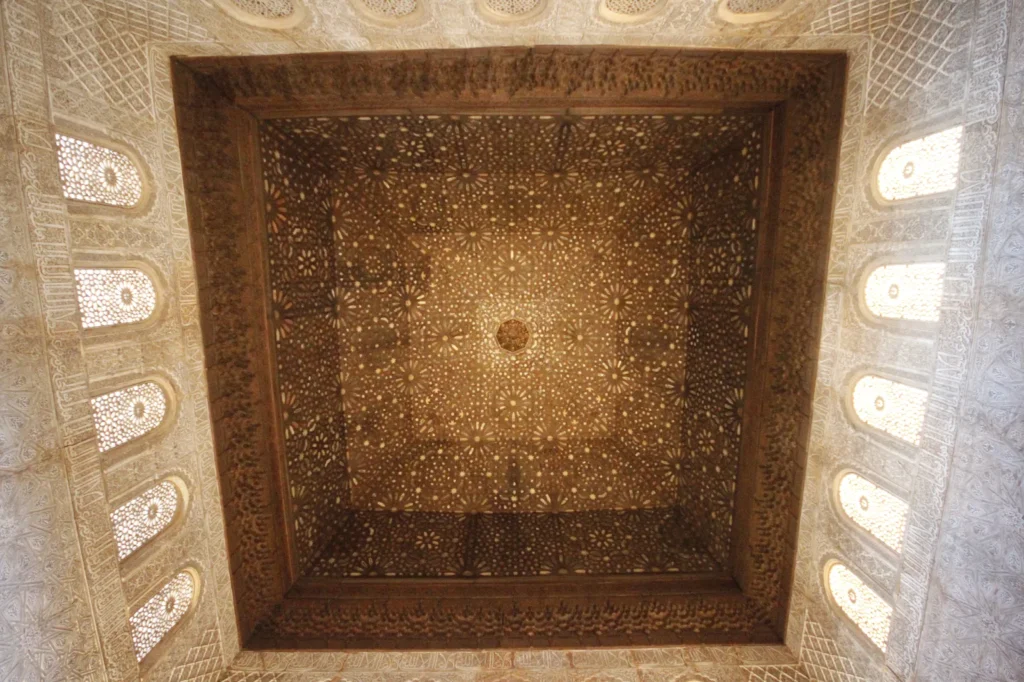
The Hall of the Ambassadors, for instance, features stunning Zellij mosaics that cover its walls, reflecting the high level of skill and artistry of the craftsmen. The Alhambra’s Zellij work not only serves as a decorative element but also as a symbol of the cultural and artistic exchange between Morocco and Spain during the medieval period.
5.2 Hassan II Mosque: Modern Grandeur with Traditional Art
The Hassan II Mosque in Casablanca, completed in 1993, is a prime example of how traditional Zellij techniques have been adapted for modern architecture. As one of the largest mosques in the world, the Hassan II Mosque features over 10,000 square meters of Zellij tilework. The intricate patterns and vibrant colors of the tiles highlight the skill and craftsmanship of Moroccan artisans. The mosque’s minaret, which stands 210 meters tall, is adorned with Zellij tiles that reflect the light and create a mesmerizing effect. This modern application of Zellij demonstrates its enduring appeal and the ability to blend traditional craftsmanship with contemporary design.
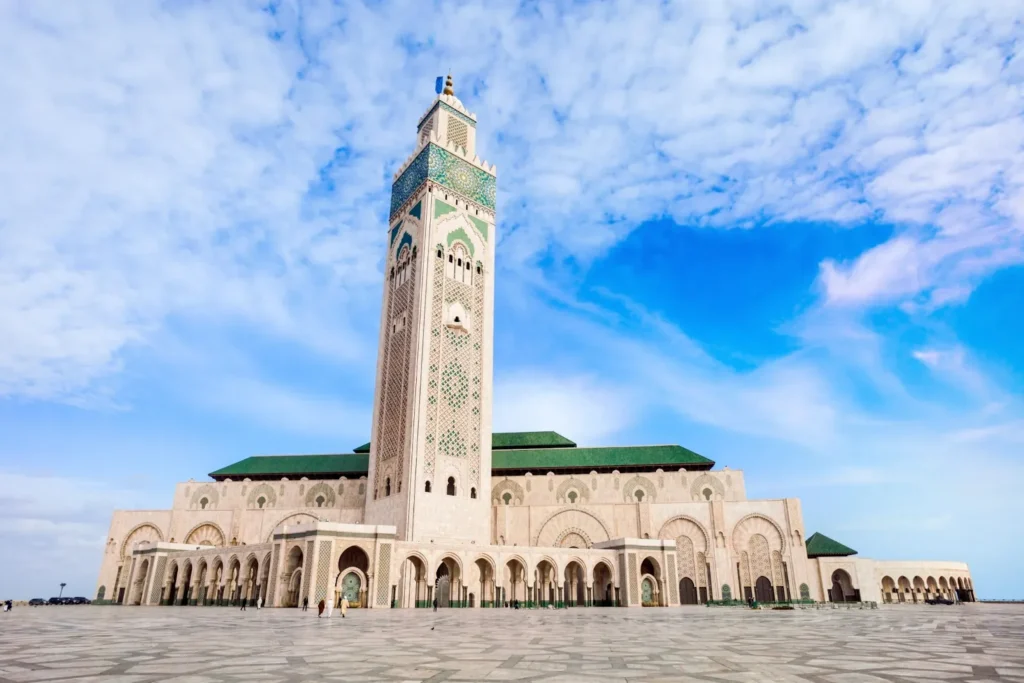
5.3 Saadian Tombs: Historical Significance and Artistry
The Saadian Tombs in Marrakech, dating back to the late 16th century, are another remarkable example of Zellij artistry. Rediscovered in 1917, the tombs house the remains of members of the Saadian dynasty and are renowned for their exquisite decoration. The tombs feature elaborate Zellij tilework, with complex geometric patterns and arabesques that adorn the walls and floors. The craftsmanship displayed in the Saadian Tombs reflects the high level of artistry achieved during this period in Moroccan history. The meticulous restoration efforts have preserved these intricate designs, allowing visitors to appreciate the historical and artistic significance of Zellij.
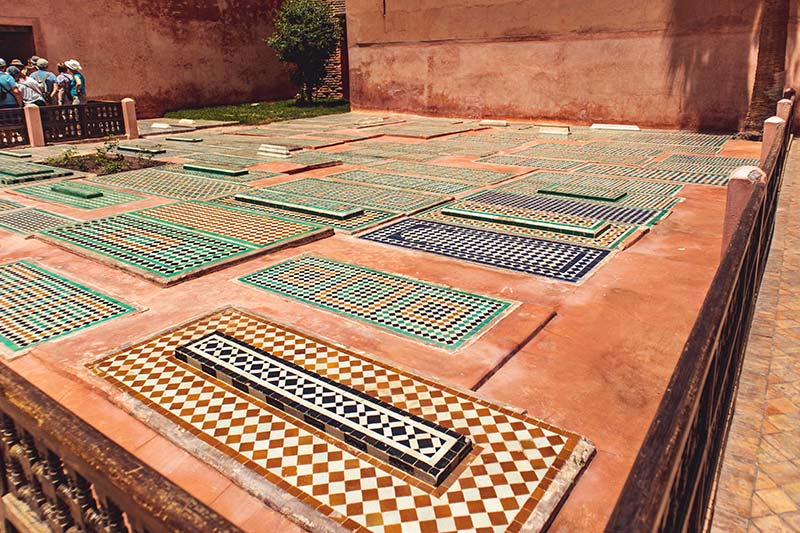
5.4 Marrakech Palaces: Architectural Marvels
The palaces of Marrakech, such as the Bahia Palace and the El Badi Palace, are architectural marvels that prominently feature Zellij tilework. The Bahia Palace, built in the late 19th century, showcases Zellij tiles in its courtyards, halls, and private chambers. The tiles’ vibrant colors and intricate patterns create a sense of opulence and elegance. Similarly, the El Badi Palace, constructed in the late 16th century, features extensive Zellij decoration that highlights the grandeur and sophistication of Moroccan architecture. These palaces serve as enduring examples of the artistic and cultural heritage of Morocco, with Zellij tilework playing a central role in their aesthetic appeal.
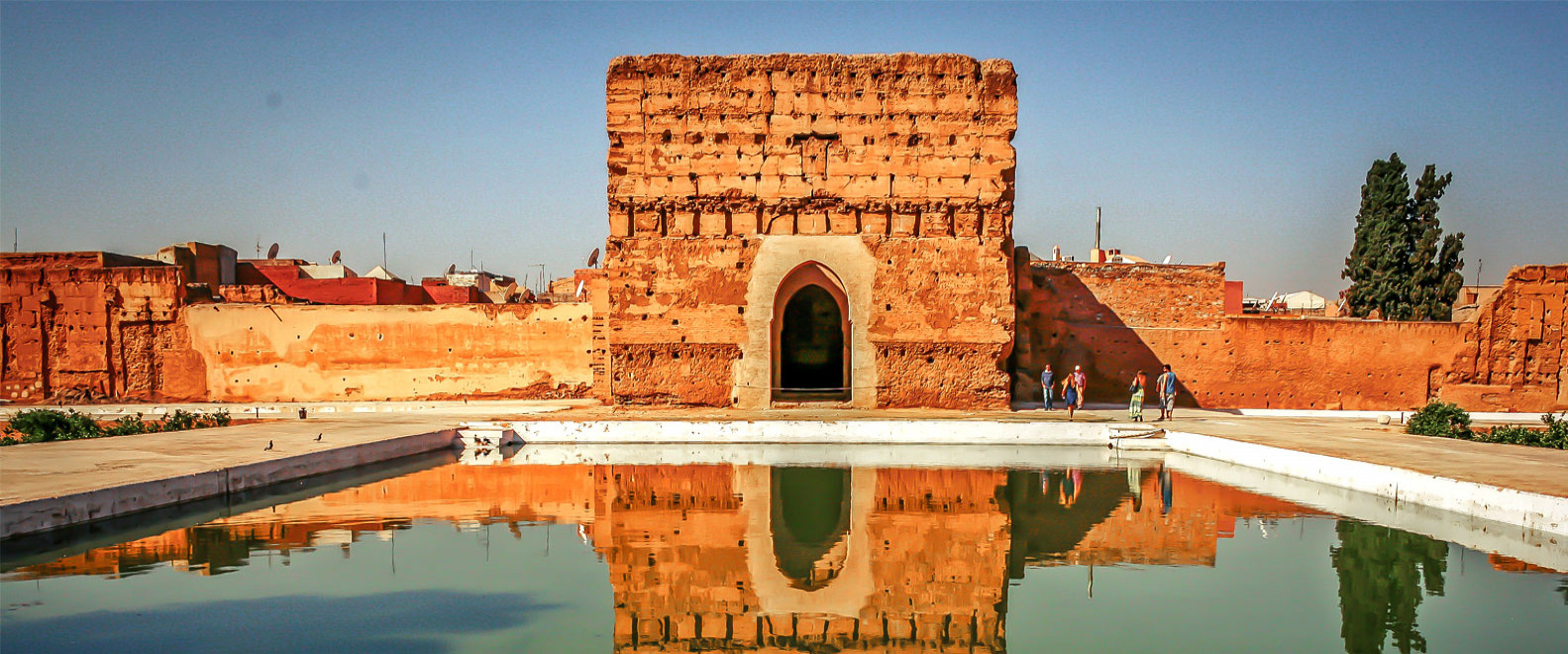
6.1 Preservation Efforts for Zellij Craftsmanship
Preservation efforts for Zellij craftsmanship are crucial to maintaining this cultural heritage. Various initiatives have been undertaken to restore and conserve historical sites featuring Zellij tilework. For example, the restoration of the Bou Inania Madrasa in Fez, a UNESCO World Heritage site, involved meticulous work by skilled artisans to preserve its original Zellij decor. These efforts often require extensive research and the use of traditional materials and techniques to ensure authenticity. Preservation projects not only protect historical art but also provide opportunities for training new generations of artisans in traditional Zellij techniques.
6.2 Revival of Traditional Techniques
The revival of traditional Zellij techniques is essential for keeping this art form alive. Organizations such as the Moroccan Ministry of Culture and various cultural heritage foundations have established training programs for young artisans. These programs focus on teaching the traditional methods of Zellij production, from clay preparation to tile cutting and assembly. By reviving these techniques, artisans can produce high-quality Zellij tiles that retain the authenticity and beauty of traditional craftsmanship. The increased interest in Moroccan design and architecture globally has also spurred efforts to revive and innovate within the Zellij tradition, ensuring its relevance in contemporary contexts.
6.3 Role of Cultural Heritage Organizations
Cultural heritage organizations play a vital role in the preservation and revival of Zellij craftsmanship. These organizations, such as UNESCO, work to protect and promote cultural heritage sites and traditional arts worldwide. In Morocco, the Maison de l’Artisan and similar institutions support artisans through training programs, exhibitions, and marketing initiatives. These efforts help raise awareness of the cultural and artistic value of Zellij, encouraging both local and international appreciation. By providing resources and platforms for artisans, cultural heritage organizations ensure that the knowledge and skills associated with Zellij are passed down to future generations, preserving this unique art form for posterity.
Q&A: Frequently Asked Questions About Zellij
What are the origins of Zellij? Zellij originated in the Islamic world around the 10th century. It became prominent in Morocco during the Marinid dynasty (13th-15th centuries). Early influences came from Andalusian artisans who brought the craft to North Africa following the Reconquista.
How is Zellij significant in Moroccan culture? Zellij is a key element of Moroccan cultural heritage, symbolizing the nation’s artistic and architectural traditions. It is widely used in mosques, palaces, and public spaces, reflecting Islamic art principles and showcasing the skill of Moroccan artisans.
What techniques are used to create Zellij? Zellij tiles are made from natural clay shaped into squares, sun-dried, glazed, and kiln-fired. Artisans then hand-cut the tiles into precise geometric shapes using a menqach (adze-like hammer) and assemble them into intricate mosaic patterns set into plaster bases.
Where can you find iconic examples of Zellij? Iconic examples include the Alhambra in Spain, Hassan II Mosque in Casablanca, Saadian Tombs in Marrakech, and the Bahia and El Badi Palaces in Marrakech. These sites feature extensive and intricate Zellij tilework.
How does Zellij influence modern design? Zellij influences modern design by integrating traditional tile patterns into contemporary interiors and architecture. It is used in luxury hotels, restaurants, and homes worldwide, combining traditional craftsmanship with modern design techniques.
What efforts are being made to preserve Zellij craftsmanship? Preservation efforts include restoration projects and training programs. Organizations like the Moroccan Ministry of Culture and UNESCO support these initiatives to teach traditional Zellij techniques to new artisans, ensuring the craft’s continuity.

